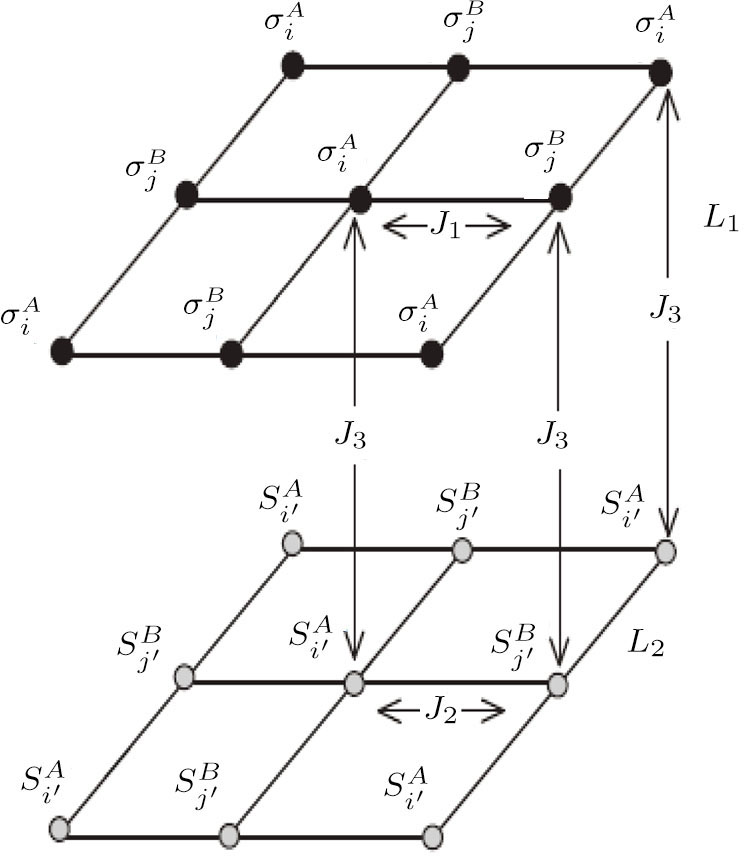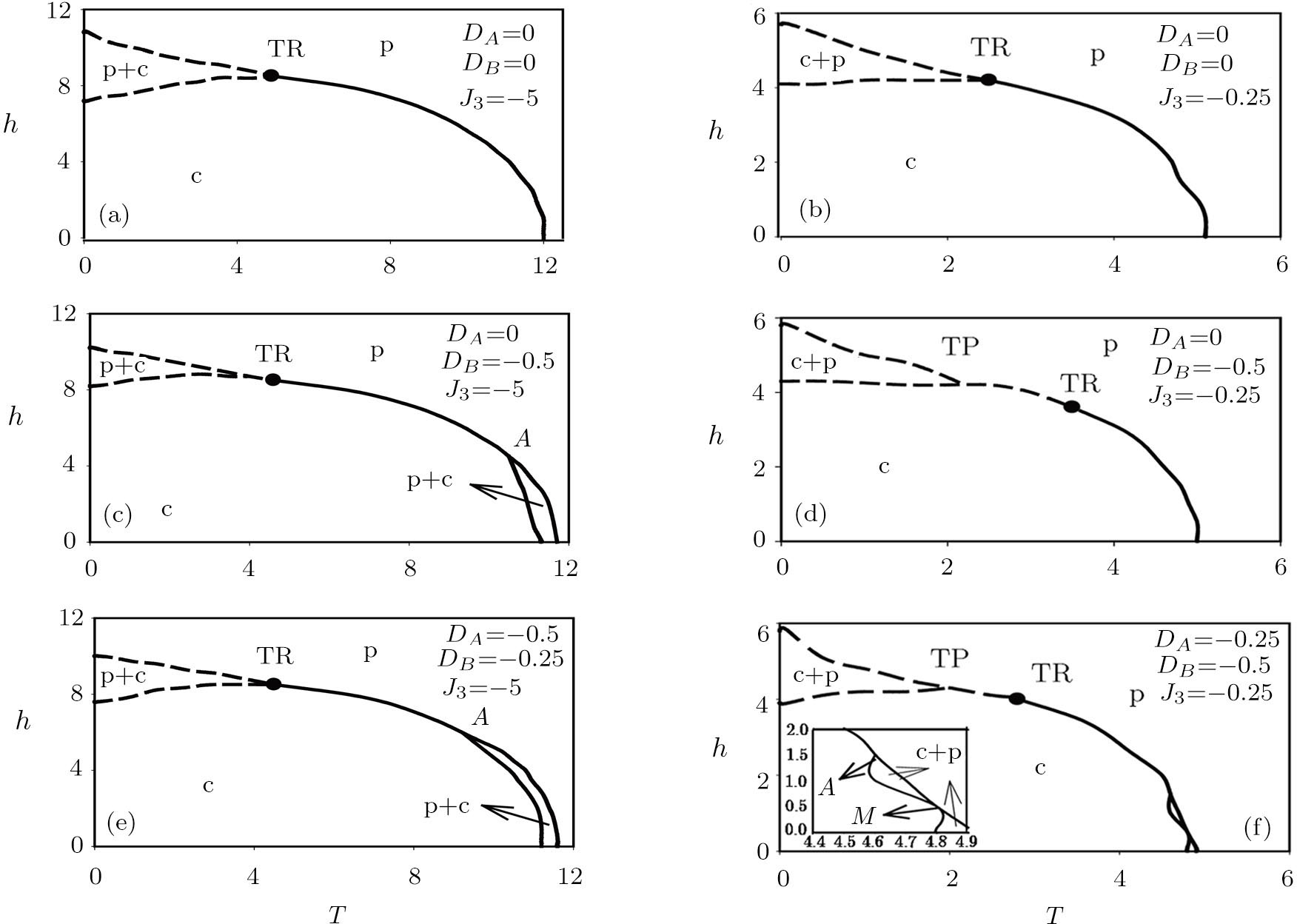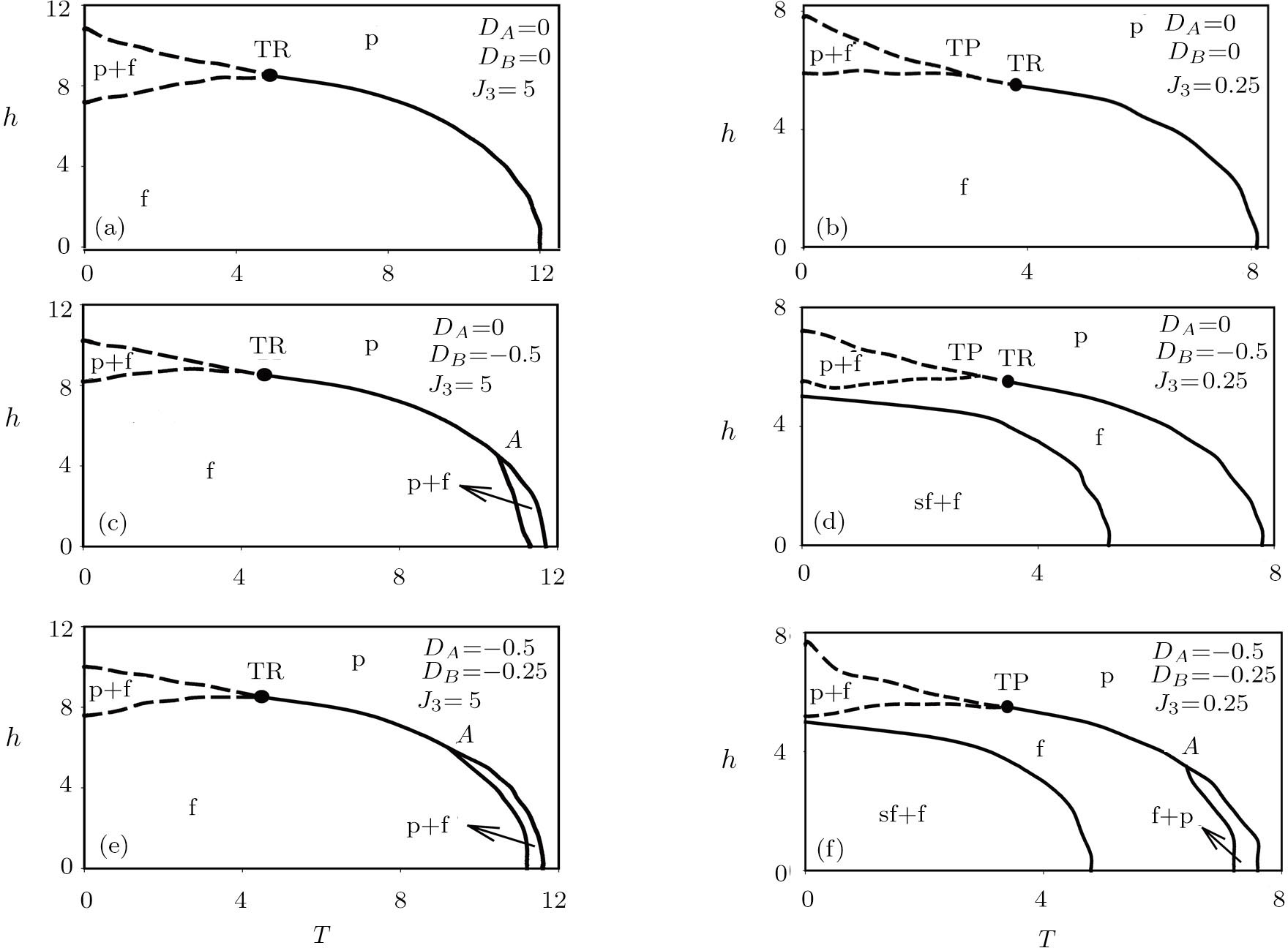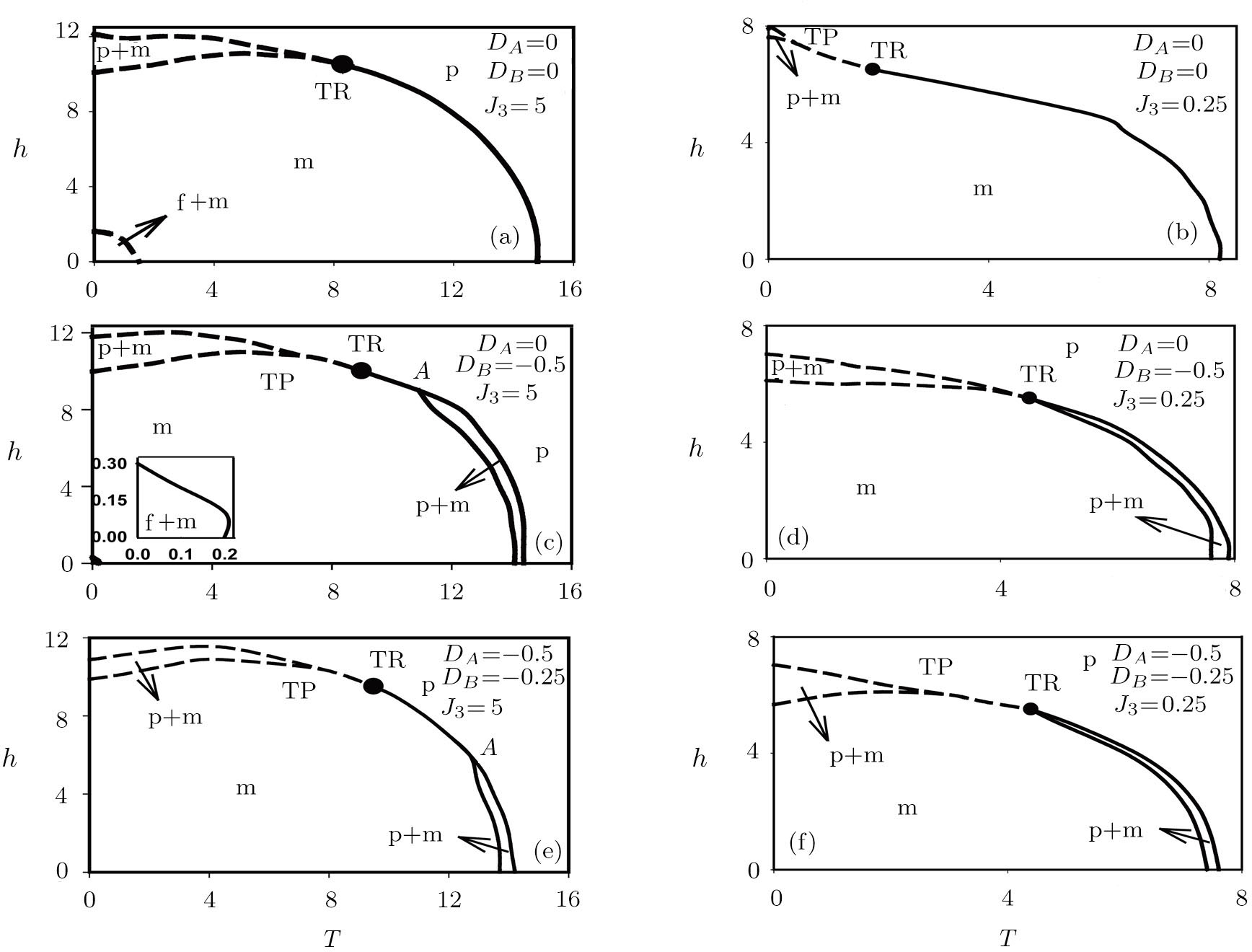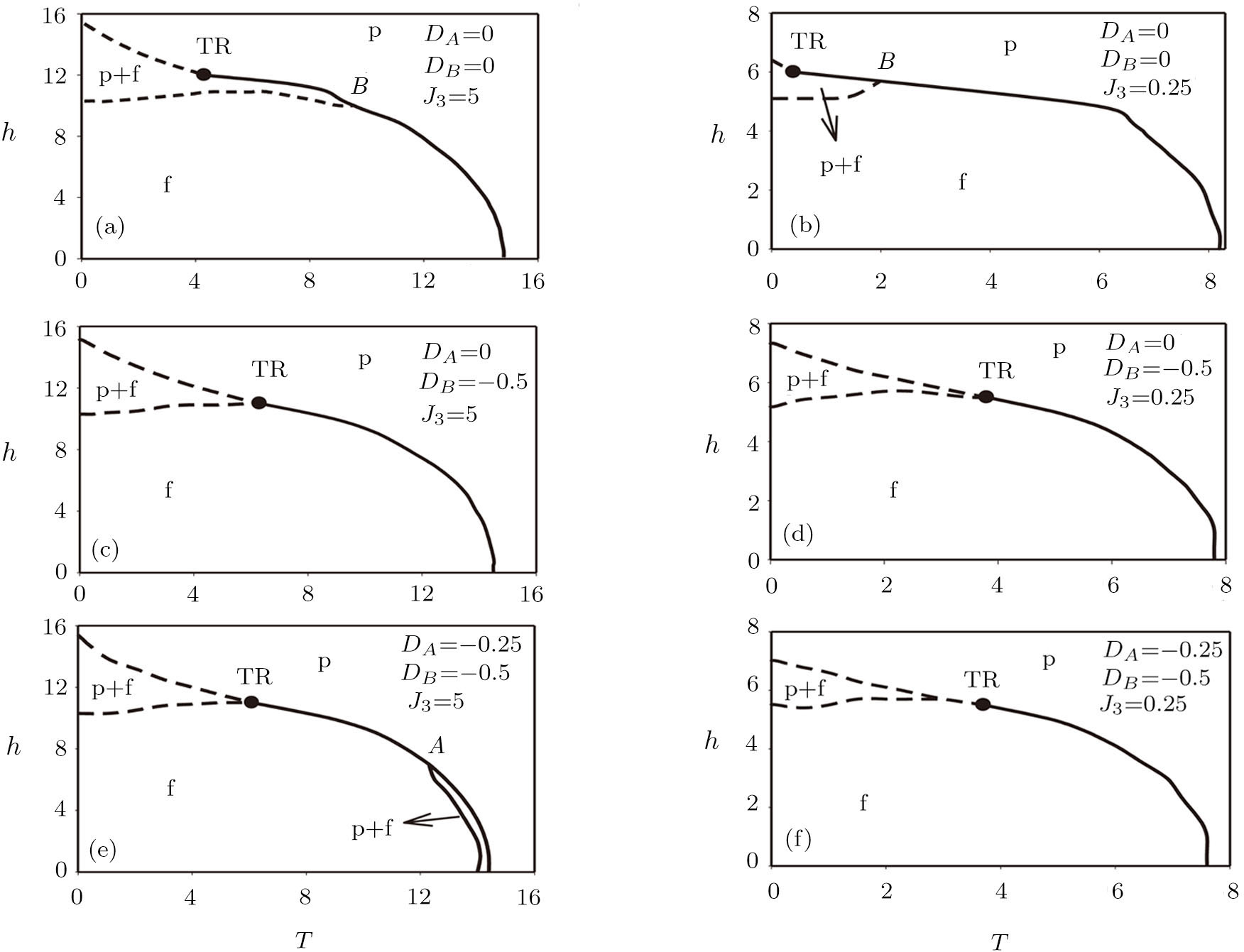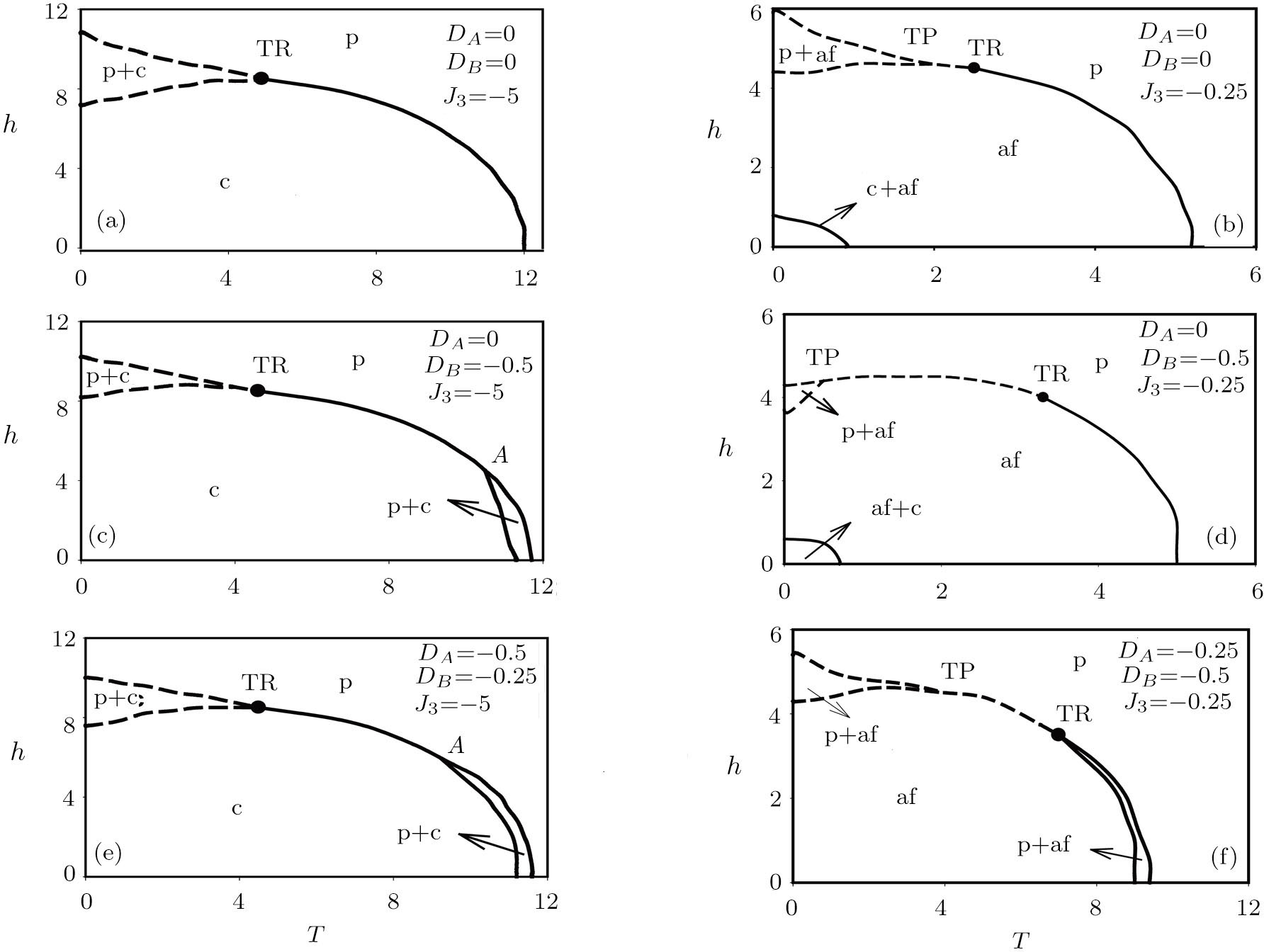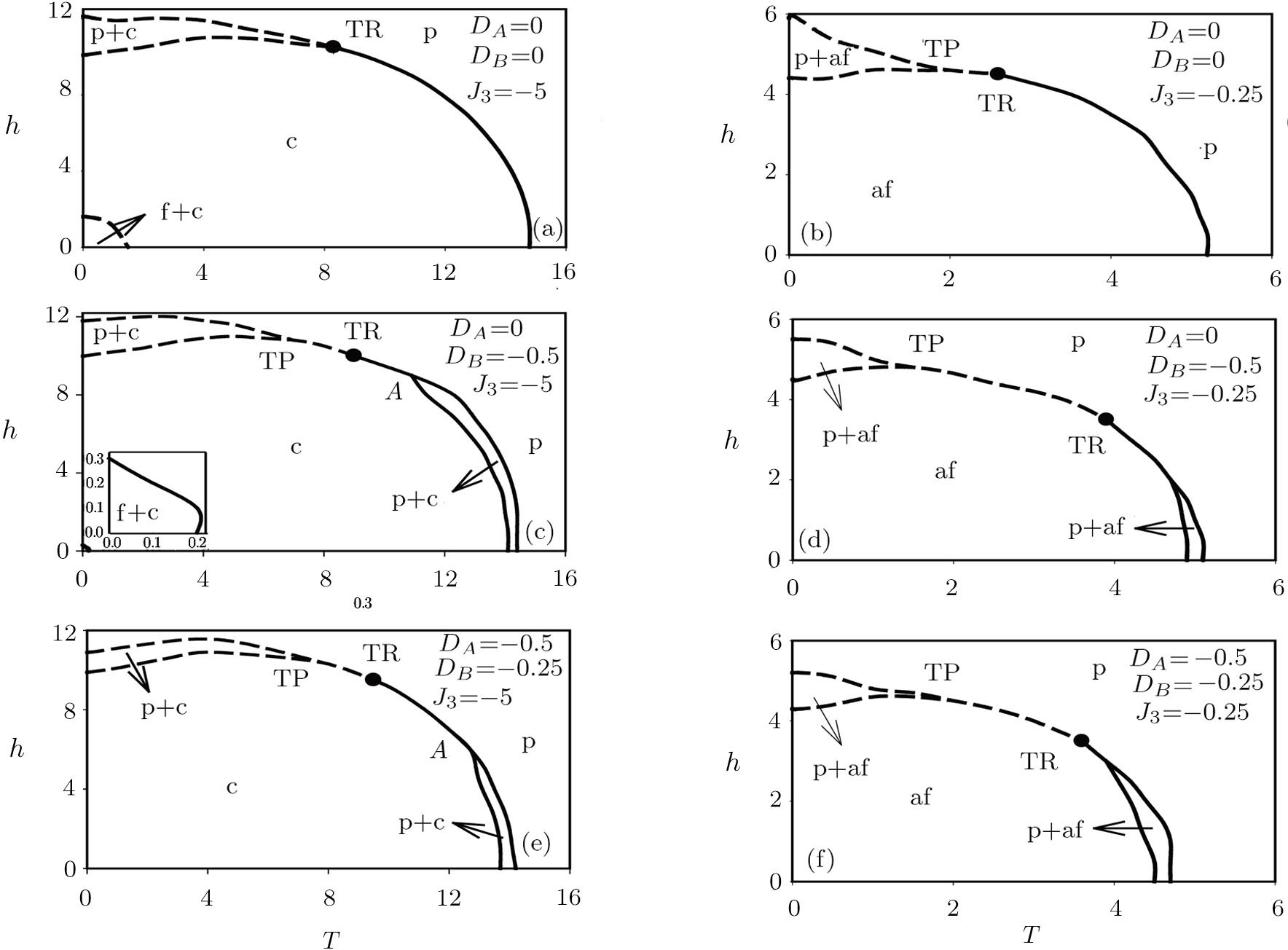Influences of Crystal-Field and Interlayer Coupling Interactions on Dynamic Phase Diagrams of a Mixed-Spin (3/2,2) Bilayer System
1 IntroductionMagnetic properties of thin magnetic films with magnetic-layered structures have been the subject of intense experimental and theoretical researches due to their great potential for technological applications, such as electronic semiconductor devices, optical coatings, computer memory, protection of substrate materials against corrosion, oxidation and wear.[1] Many works have been experimentally investigated on the magnetic properties of the bilayers and multilayers thin films, such as Co/Pt, Pt/Co/Pt, Pt/Co/AlOx, Gd-Co/Ti, W/B4C, CoSiB/CSiB, Cd/Pd, Ni-Zr, Ni/Ti, Fe/Ni, Fe/Co, Ni/Au, Co/Cu/Ni80Fe20, La2/3Ca1/3MnO3/SrTiO3/YBa2Cu3O7 − x, FePt/Fe, and Fe/TbFe etc. (see Refs. [2–17] and references there in). Theoretically, the spin-1/2 (see Refs. [18–30] and references therein), spin-1 (see Refs. [31–35] and references there in) and also mixed Ising systems, namely spin (2, 5/2),[36–37] spin (1, 3/2),[38] spin (3/2, 2)[39] and spin (3/2, 5/2),[40] have been used to study magnetic behaviors of the bilayers and multilayers thin films within the methods of the equilibrium statistical physics. Moreover, the bilayer spin-1,[41] spin-3/2,[42] spin[43] as well as mixed-spin[44–45] systems on the Bethe lattices have been also investigated to observe some magnetic properties of thin films. Dynamic magnetic properties of thin films have been examined by using the spin-1/2,[46–50] spin-1,[51–53] mixed-spin (2, 5/2),[54–55] mixed-spin (3/2, 2)[56–58] bilayer systems. In recent years, magnetic phase diagrams of ferrimagnetic mixed-spin system have been studied comprehensively (see Refs. [59–61] and references therein).
In spite of these studies, the dynamic magnetic critical properties of bilayer systems have not been investigated in detail. In particular, the crystal-field interaction, in which one of the important interaction parameter, either taken as zero or taken as same (D) for A and B sublatices in all these studies, except Ref. [57]. In Ref. [57], the crystal-field interaction for sites on A lattice as DA and for sites on B lattice as DB were taken and only the dynamic phase diagrams (DPDs) in ferromagnetic spin (3/2, 2) bilayer system was investigated. In this paper, influences of crystal-fields (DA and DB) and interlayer coupling interactions (J3) on dynamic magnetic behaviors of a mixed-spin (3/2, 2) bilayer system under a time-dependent magnetic field are investigated by the Glauber-type stochastic (GTS) dynamics based on the mean-field theory (MFT) in detail. For this aim, the DPDs are presented in the reduced temperature (T) and magnetic field amplitude (h) plane for the ferromagnetic/ferromagnetic (FM/FM), antiferromagnetic/ferromagnetic (AFM/FM) and AFM/AFM interactions. The effect of the DA, DB as well as J3, which is related to the thickness, on the critical behaviors of the system are extensively studied and discussed.
2 Model and FormulationWe take into account a mixed-spin (3/2, 2) model with a two-layers, namely L1 and L2, on a square lattices, shown in Fig. 1. Each layer of the model contains two sublattices (A and B) with spin variables  ,
,  occupy L1 layer and
occupy L1 layer and  ,
,  layer. Thus, the system can be portrayed with four sublattice magnetizations that are introduced as follows:
layer. Thus, the system can be portrayed with four sublattice magnetizations that are introduced as follows:  ,
,  ,
,  ,
,  denotes the thermal expectation value. Each layer has N sites and interacts with its nearest-neighbor (NN) and the corresponding adjacent spins in the other layer whose sites are labeled by i, i′, j and j′, as illustrated in Fig. 1.
denotes the thermal expectation value. Each layer has N sites and interacts with its nearest-neighbor (NN) and the corresponding adjacent spins in the other layer whose sites are labeled by i, i′, j and j′, as illustrated in Fig. 1.
The Hamiltonian of the system can be given by
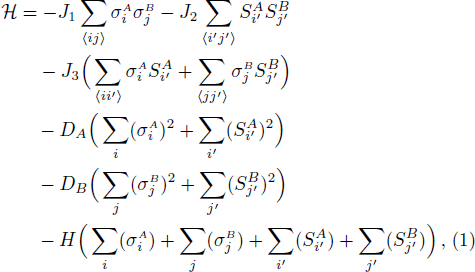
where ⟨
ij ⟩ and ⟨
i′
j′⟩ represent a summation over all pairs of the NN sites of each layer.
J1 and
J2 are exchanging interactions for the
L1 and
L2 layers, respectively, also called intralayer coupling constants, and
J3 is the interlayer coupling constant over all the adjacent neighboring sites of layers, as illustrated in Fig.
1.
H is an external field that is
H =
H0 cos(
wt),
H0, and
w = 2
vπ are the amplitude and the angular frequency, respectively.
DA and
DB represent the crystal fields for sites on
A and
B lattices, respectively. The system is in contact with an isothermal heat reservoir at absolute temperature
TA.
The set of mean-field dynamic equations for sublattice magnetizations are found by using the GTS dynamics; hence the system evolves according to the GTS process at a rate of 1/τ transitions per unit time. We identify P(σ1,σ2,..., σN,S1,S2,...,SN;t) as the probability that the system has σ- and S-spin configurations in each layer σ1,σ2,...,σN,S1,S2,...,SN at time t. Let Wi  be the probability per unit time that the i-th spin changes from the values
be the probability per unit time that the i-th spin changes from the values  to
to  , while the others, i.e., (S1,S2, …, SN) and spins on sublattice B, remain momentarily fixed, then the master equation can be written in which describes the interaction between the spins and the heat reservoir as
, while the others, i.e., (S1,S2, …, SN) and spins on sublattice B, remain momentarily fixed, then the master equation can be written in which describes the interaction between the spins and the heat reservoir as

where

is the probability per unit time that
i-th spin changes from the values

to

. Each spin can change from the value

to

with the probability per unit time due to the reason that the system is in contact with a heat bath at absolute temperature
TA,

where
β = 1/
kBTA,
kB being the Boltzmann factor,

is the sum over the five possible values of

and

is the change in the energy of the system when the
σi spin changes and it is defined as

The probabilities satisfy the detailed balance condition. Utilizing Eqs. (1)–(4), we calculate the mean-field dynamical equation for the average magnetization on the sublattice A, i.e.,  as
as

where
ς =
ωt,

,
h =
H0/
J1,
dA =
DA/
J1 and Ω =
τω,
z = 4 and
ω = 2
πv are taken. The mean-field dynamical equation for the average magnetizations of
m1B,
m2A, and
m2B can be similarly obtained as



where
dB =
DB/
J1. The solutions and discussions of these mean-field dynamical equations will be given and discussed in Sec.
3. In numerical calculations, we fixed
J1 = 1,
dA =
DA, and
dB =
DB.
3 Numerical Results and DiscussionEquations (5)--(8) were solved by the Adams-Moulton predictor-corrector method to find phases in the system for the FM/FM (J1 > 0 and J2 > 0), AFM/FM (J1 < 0 and J2 > 0) and AFM/AFM (J1 < 0 and J2 < 0) interactions for the given system parameters and initial values. Since the solution of these kind of dynamic equations were presented[46,50,54–57] in detail, the solutions are not discussed and figures are not given. From these investigations we find that the system comprises, depending on system parameters, the paramagnetic (p),  , the ferromagnetic (f):
, the ferromagnetic (f):  , the compensated (c):
, the compensated (c):  and
and  , fundamental phases, and the f + p, f + c mixed phases for the FM/FM interaction. The p, af, antiferromagnetic (af):
, fundamental phases, and the f + p, f + c mixed phases for the FM/FM interaction. The p, af, antiferromagnetic (af):  ,
,  , the surface (sf):
, the surface (sf):  ,
,  phases and the f + p, af+p, sf + f, sf + af mixed phases for the AFM/FM interaction. The p, af, and mixed (m):
phases and the f + p, af+p, sf + f, sf + af mixed phases for the AFM/FM interaction. The p, af, and mixed (m):  phases and the af + p, m+p, m+f, sf + f, sf + af mixed phases for the AFM/AFM interaction. We should also mention that since the some similar typical results for the dynamic magnetization curves for different magnetic phase states were given by Refs. [50, 56, 62–64], we do not present the dynamic magnetizations curves in order to avoid some overlaps.
phases and the af + p, m+p, m+f, sf + f, sf + af mixed phases for the AFM/AFM interaction. We should also mention that since the some similar typical results for the dynamic magnetization curves for different magnetic phase states were given by Refs. [50, 56, 62–64], we do not present the dynamic magnetizations curves in order to avoid some overlaps.
To study the effects of DA, DB, and J3 on the DPDs, one has to investigate the temperature dependence of the dynamic magnetizations  as a function of the reduced temperature (T) that are defined as
as a function of the reduced temperature (T) that are defined as

Equation (
9) was solved by combining the numerical methods of the Adams-Moulton predictor corrector with Romberg integration to obtain the dynamic phase transition (DFT) points and also to characterize the nature of the transitions. From these detail solutions and investigations we find that the system undergoes either a first- or second-order phase transitions that depending on interaction parameters; hence we also obtained the DPT points. The DPDs are given in the (
T,
h) planes for the FM/FM, AFM/FM and AFM/AFM interactions, seen in Figs.
2–
7. In the figures, the dashed and solid lines illustrate the first- and second-order phase transition lines, respectively.
TR,
A,
M, and
B are the dynamic tricritical, multicritical, tetracritical and critical end points, respectively. Finally, the TP represents the triple point.
Figures 2 and 3 show the DPDs of the FM/FM interactions for the repulsive (J3 > 0) and attractive (J3 < 0) interlayer coupling constant, respectively, and J1 = 1.0, J2 = 1.0, various values of DA and DB. From Fig. 2, we have seen following interesting phenomena: (i) For DA = DB = 0, the system contains the p, f and f+p phases as well as TR and B special critical points. The dynamic phase boundaries between the f+p and f phases and between the f+p and p for high values of h are first-order lines. The dynamic boundaries between the f and p phase and between the f+p and p for low values of h are second-order lines, seen Figs. 2(a) and 2(b). (ii) For DA ≠ 0 and DB = 0 or wise versa, the DPD is like to Fig. 2(a), except the B disappears and the first-order line between the p+f and f terminates at TR, illustrated Figs. 2(c) and 2(d). (iii) For DA ≠ 0 and DB ≠ 0, the phase diagrams are similar to Fig. 2(c), except the A special critical point and the f+p appear for the low values of h and high values of T. The phase boundaries among the f, p+f and p phases are second order-phase lines (Fig. 2(e)). Moreover, if DA > DB the A point and a new p+f mixed phase appear at lower values of h and higher values of T, compare Fig. 2(c) with Fig. 2(e). For small values of J3, the A critical point and p+f phase do not appear (Fig. 2(f)). Figure 3 (J3 < 0) illustrates the effect of J3, if one compares with Fig. 2, one can see the basic and important difference is that the c phase occurs instead of the f phase. Moreover, the following influences have been also observed: (i) The B point is not observed in Fig. 3. (ii) The TP appeared in Fig. 3(d). We should also mention that the behavior of Figs. 3(a), 3(c), and 3(e) are akin to Figs. 2(a), 2(c), and 2(e). Figure 3(f) displays more richer critical behaviors in which for high values of T and low values of h, the A, M special critical points and two more the p+c phase are observed. The boundaries among these phases are second-order lines.
Figures 4 and 5 display the DPDs of the AFM/FM interactions for the repulsive (J3 > 0) and attractive (J3 <0) interlayer coupling constant, respectively, J1 = −1.0, J2 = 1.0 and various values of DA and DB. From Fig. 4, we have seen following interesting phenomena: (i) For DA = DB = 0, the system contains the p, f and p+f phases as well as the TR tricritical point. The dynamic phase boundaries among the p+f, f and p phases are first-order lines but the dynamic boundary between the f and p phase is a second-order, seen in Fig. 4(a). For small values of J3, the TP point is also observed (Fig. 4(b)). (ii) For DA ≠ 0 and DA = 0 or wise versa, the DPD is akin to Fig. 2(a), except followings; A critical point and the p+f mixed phase appear for the low values of h and high values of T, seen in Fig. 4(c) and the new f+sf phase occurs at low values of T and h. (iii) For DA ≠ 0 and DA ≠ 0 (Figs. 4(e) and 4(f)), the phase diagrams are very similar to Fig. 4(c), except the A special critical point and one more the p+f phase occur at high values of T and low values of h, seen in Fig. 4(f). (iv) For small values of the J3 the sf+f mixed phase occurs at low values of T and h, and the boundary between the sf+f mixed and f phases is a second-order phase line (Fig. 4(f). The behavior of DPDs in Figs. 5(a), 5(c) and 5(e) are similar to Figs. 4(a), 4(c) and 4(e), but the difference is that the f phase transforms into the c phase. Fig. 5(b) displays the same behavior as Fig. 5(a), except the c phase turns to the af and the TP point and the c+af mixed phase at low T appear. The DPD in Fig. 5(d) is similar to Fig. 5(b), except the reentrant behavior is observed. Fig. 5(f) illustrates the same behavior as Fig. 5(b), but differences are following. (i) The c+af at low T disappears and the new p+af phase is seen. (ii) The boundaries among the af, p+af and p phases are second-order lines.
Figures 6 and 7 display the DPDs of the AFM/AFM interactions for the repulsive (J3 > 0) and attractive (J3 < 0) interlayer coupling constant, respectively, J1 = −1.0, J2 = −1.0 and various values of DA and DB. First of all, only Figs. 6(a), 6(c), 6(e) display a reentrant behavior. For DA = DB = 0 (Figs. 6(a) and 6(b)), the system contains the p, m and p+m as well as the TR tricritical point. The f+m mixed phase occurs for high values of J3 (Fig. 6(a)) and the TP point is seen for low values of J3 (Fig. 6(b)). Moreover, the dynamic phase boundaries among the p+m, m and p phases and the boundary between the f+m and m are first-order phase lines but the dynamic boundary between the m and p phase is a second-order line. Figure 6(c) is like Fig. 6(a), but the DPD in Fig. 6(c) contains the new p+m phase and the TP, A points at high values of T. The boundary between the m and f+m, and the boundaries among m, p+m and p are second-order lines. The DPD in Fig. 6(d) displays same behavior as Fig. 6(c), except the TP, A points and the p+m phase as well as the reentrant behavior do not occur. The topology of Fig. 6(e) is very akin to Fig. 6(c), except the p+m phase does not occur. The behavior in Fig. 6(f) is very similar to Fig. 6(d), except the TP point also appears. The behavior of Fig. 7 is similar to Fig. 6, except following two main differences: (i) The m phase turns into the c phase in Figs. 7(a), 7(c), 7(e) and the af phase in Figs. 7(b), 7(d), 7(f). (ii) The TR appears for lower values of h.
In conclusion, we study influences of crystal-fields (DA and DB) and interlayer coupling (J3) interactions on the DPDs of the mixed-spin (3/2, 2) bilayer system for the FM/FM, AFM/FM, and AFM/AFM cases in the presence of a time-varying magnetic field within the GTS dynamics based on the MFT. We investigate the influence of the DA, DB as well as J3 on the DPDs and find that their effects on the dynamic magnetic critical properties of the DPDs more for the FM/FM, AFM/FM interactions, but less for the AFM/AFM. In particular, the sign and magnitudes of J3 are mostly effect the phases in the system and the DA and DB mostly affect the critical behavior of the DPDs. Finally, it is worthwhile to mention that the mixed-spin (3/2, 2) bilayer system also shows the compensation behavior as the other mixed-spin bilayer systems[59–63,65] that the comprehensively study should be worked out.








